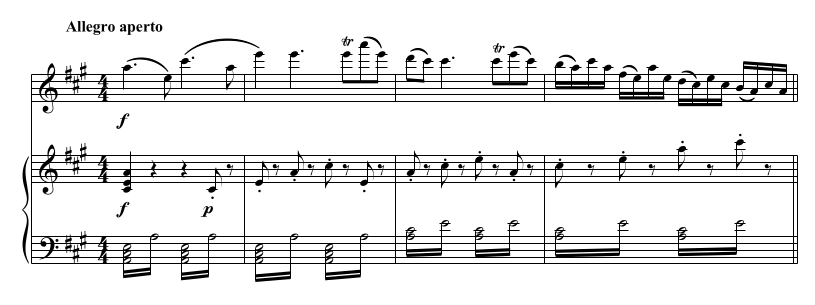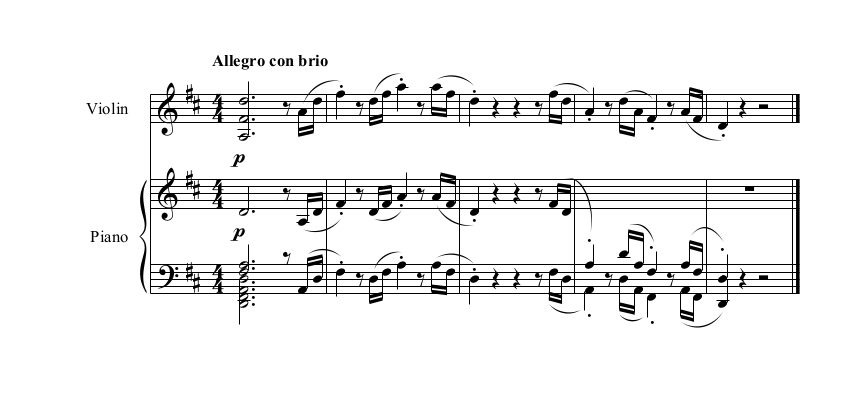More than 'loud' and 'quiet'
When you see a 'f' or 'p', what is the first thing that comes to your mind? Many people would say loud for 'f' and quiet or soft for 'p'. In this article we are going to talk about what kind of message composers are trying to give us by dynamic markings.
Hidden messages from composers
When composers add dynamics in their music, they are telling us more than how big or quietly they want us to play. If they indicate a 'p' that's because they hear certain quality in that particular part of the music, and 'p' is the best way to describe it. They could write espress. or dolce but that is not feasible to do it every 8 measures. Writing down a dynamic marking is often the best method to help us feel the atmosphere of the music the way composers intended.
Therefore, we are missing a very important message that composers are trying to tell us if we are just thinking about the volume of the sound when we see a dynamic marking. Our job as a performer is to find the meaning behind the dynamic marking composers left for us. In order to determine what kind of 'f' or 'p' you want to play with, consider these elements along with the dynamic markings:
- Tempo. How fast or slow is this music supposed to be?
- Length of the notes. Are there mainly short notes or long notes in the passage? Is the melody written with short notes while the accompaniment is mostly long notes?
- Articulation such as slurs and staccato. Are slurs dominating the phrase, or you see more staccatos than slurs?
- Register of the notes. Is the main melody in the high voice or low voice? Are they in the comfortable or uncomfortable range for the instrument?
- Keys and chord progression. Are you in the main key? Was there a sudden key change? Are the chords moving slowly or quickly? Are the chords predictable or surprising? Are open intervals prominent, or are there many dissonances?
- Instrumentation or orchestration. Which instrument or a section in an ensemble carries the main melody? How does your part fit in to that in terms of tone color?
Now look at the dynamic marking and see if you hear something more than loud and quiet in the music. If you do, you are hearing characters associated with the dynamic markings. When you hear a certain character in music, the music gains life!
Can you hear and feel music from the dynamic markings?
Let's take a look at some examples.
The first example is the Mozart's Concerto No.5.

Do you hear anything more than a big dynamic level? Mozart gives us a clue in this one. He writes "Allegro aperto". Aperto means 'open'. It's an 'open' sort of 'f'. We can think more about what kind of forte it should be starting from the clue Mozart gave us.
Look at the left hand of the piano part, which is originally the string section. It has 16th notes which indicates quick motion in the music. If these were written half notes it would give a completely different sort of atmosphere. And the right hand of the piano, which is the 1st violin part in the orchestra, has ascending 8th notes which add to the excitement of the 16th notes accompaniment.
Let's not forget about the key signature. Mozart chose the A major for this concerto. Was it random that he chose the A major? What if this was written in D♭ major? Every key has its own color, we need to develop our senses to feel the tonal differences each key holds.
You take all these things into consideration when you determine what kind of forte the passage should be. To me this is a kind of forte that is bright and optimistic, driving forward with full of energy.
The next example we will look at is the opening passages from the Mendelssohn's Violin Concerto.

Let's think about how you would play the first 3 repeated Bs. It is 'p' but do you think it is good enough if you played it quietly? Well, the clear answer is 'no'. Then what kind of 'p' is it? The first clue he gives us is the indication of "Allegro molto appassionato". It is that sort of 'p', whatever that means to you.
Then look at the orchestra part (the example shows a piano reduction). The strings play the 8th notes while the double bass and timpani play the quarter notes. Also, notice there are long slurs on the 8th notes, which indicates smoothness over the notes. Think about what kind of atmosphere and texture all these things would create.
Mendelssohn provided a 'p' in addition to what we just discussed. He heard certain musical quality in this opening passage, and decided 'p' would best describe it. In other words, 'p' is just another way to tell us what kind of music he was thinking of. It is a dynamic marking but more importantly, it is a musical marking.
Now, move onto the next example, which occurs only 20 bars or so after the previous example. We see the same repeated 3 Bs, but this time things are not the same.

First, there is a crescendo going up to a 'f'. There are still slurred 8th notes but they end at the 'f', at which point all we have are the 3 quarter notes in the orchestra part with staccato on some of them. There is a clear change in the texture now. It doesn't show in this example but the music builds up to the 'f' as the arrival point as well.
Mendelssohn writes a 'f' this time. What did he hear? These are the same 3 notes as the first example but how should they be different this time? Again, just playing with a big dynamic wouldn't be good enough. Find hints that the composer left for us, and we should come up with a musical idea based on them. Like when it was a 'p', think of the 'f' more as a musical suggestion than merely a dynamic marking.
Let's move onto the next example, the opening of the 1st Violin Sonata by Beethoven.

It is marked 'f'. In conjunction with the tempo marking "Allegro con brio" you may already have an idea of what kind of 'f' this opening passage should be. Now, let's see how you would look at this passage differently if it was marked 'p'.

Besides it is going to be softer in volume, do you get a different feel about the music? Maybe something more gentle, energetic in a muted way, or trying to whisper something exciting. Whatever they might be, if you give some thoughts to it you should be able to feel something more than quiet.
You will also notice that Beethoven indicated staccato on the quarter notes. What if these were dotted quarter notes with no staccato? Let's think about the differences and see if that would give you more ideas as to what kind of 'f' you hear.
Below is another example, a Violin Sonata by Mozart.

Mozart starts this E minor Sonata in piano. However, in the recapitulation he adds a series of forte on the dotted half notes on the downbeats.

He clearly wants something different this time around. What is it that he is after? Does he just want loud downbeats? What did he really mean by putting forte on the downbeats? Observe how the piano part is different this time from before. What is he trying to achieve by placing separated 8th notes instead of slurred quarter notes? Look at the chord in measure 2 of each excerpt; it is an E minor chord in the 1st excerpt but it is an augmented 6th chord (German 6th chord) in the 2nd excerpt. Does that give you any different feelings compared to the 1st time?
When you think about things like that you will start to see all kinds of tonal colors and characters in the music, and how composers are trying to show us musical details by the indication of dynamics. They are not merely a suggestion of playing it loud or quiet.
Give a musical meaning to a dynamic marking
Now that we examined dynamic markings and what they could mean musically, we can start to look at dynamic markings as an important tool and guide to understand music. These dynamic marking are more about the character of the music than how loudly or quietly we should play. They are clues for us to understand what composers heard musically, not the volume of sound they heard.